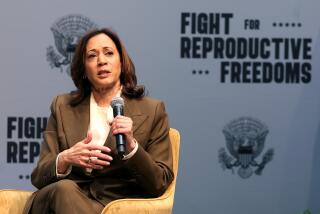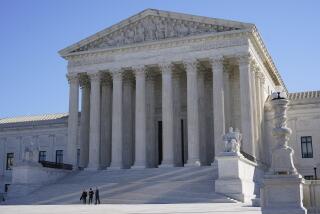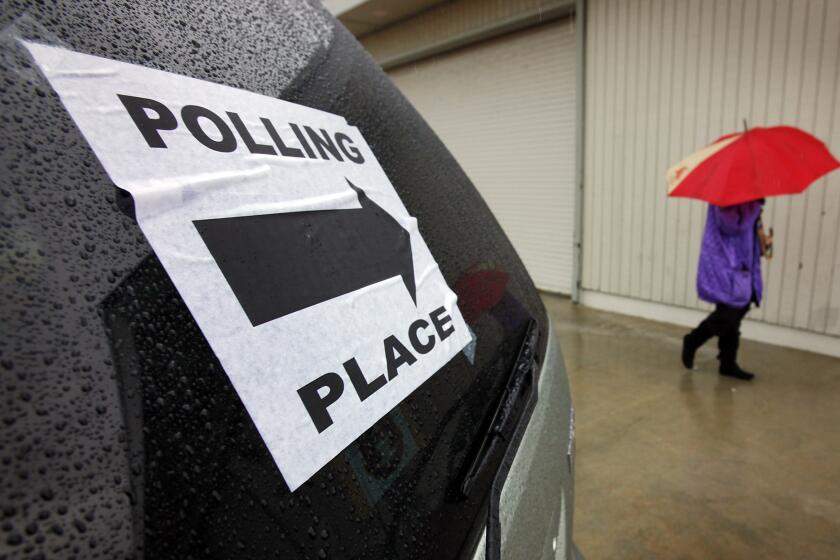‘Wedge Issue’ That Pierces GOP’s Heart : Abortion:The GOP is trying to adjust its policy as its ‘principled’ ideological stand now becomes a political liability.
NEW YORK — For Republican National Committee Chairman Lee Atwater, it must have been like waking up on a bright sunny morning in his native South Carolina, looking out the window and finding 16 inches of snow on the ground. Nov. 8, 1989, was that kind of day.
The Republican Party had endured mini-slaughter at the polls. Democratic Lt. Gov. L. Douglas Wilder was the newly elected governor of Virginia. Although the margin of victory was razor-thin, in the world according to Atwater, the fact that Wilder, a black man, had won meant something fundamental had shifted in American politics.
In the “real” world, it was axiomatic that no state would elect a black governor. In 1982, amid the worst recession since the Great Depression, California voters had backed off at the last moment and elected white Republican George Deukmejian over black Los Angeles Mayor Tom Bradley. “Realists” knew that in a generic Virginia gubernatorial election, Wilder would receive 45% of the vote. He was attractive and enormously skillful. But he was black, liberal and had supported many tax increases over the years. In other words, he was, at best, a 45-percenter.
Yet, on Election Day, Wilder defeated GOP stalwart J. Marshall Coleman by 7,000 votes (subject to recount). Even more astonishing was Wilder’s vote total--roughly 900,000. That was 140,000 more votes than Charles S. Robb received when he defeated Coleman in 1981, 160,000 more than incumbent Gov. Gerald L. Baliles pulled when he won in 1985.
Abortion was the difference. You only had to look at the returns from Fairfax, Chesterfield and Henrico counties--George Bush country to the core--to know that abortion was now a voting issue for white suburbanites. The Supreme Court’s decision giving states the option of imposing new restrictions on abortion (Webster vs. State of Missouri) radically altered the political terrain. When the Wilder campaigners worked the final spending percentages, they found that nearly 40% of their media budget had been devoted to getting the word out that their man was pro-choice and that Coleman was not.
Webster made abortion a voting issue for the white middle class and energized a previously complacent grass-roots organizations. If Democrats learn the lessons of Virginia, the abortion issue could haunt the GOP for years.
Until the Webster decision, “social issues” seemed to be the sole province of the Republican Party, particularly on the national level. The reaction to the civil-rights movement, cultural liberalism and the Vietnam War had virtually destroyed the Democratic Party in presidential elections.
In 1972, President Nixon’s team had a quick summary of Sen. George S. McGovern’s candidacy that seemed to capture the televised chaos of the Democratic Party and its national convention that year. McGovern was the “3-A’s” candidate--”acid, amnesty and abortion.” The Nixonites drove that theme hard with white Catholics in the North and white Protestants in the South on the way to the largest Republican landslide in American history.
It was the culmination of the grand Nixon plan--the so-called Southern Strategy--to drain the Democratic Party of white middle-class voters and thus deny it national political legitimacy for a generation. It worked, with one unhappy intermission--when a “born-again” Christian from Georgia went to Washington--and Republicans have controlled White House access ever since.
Atwater had his own spin on “social” issues--he called them “wedge issues.” His idea was to find the wedge issue that sharply divides the opposition, and drive it home. The wedge issues of 1968, 1972, 1980, 1984 and 1988 were race, cultural liberalism, patriotism, abortion, anti-communism and Big Government. Abortion is still a wedge issue, but post-Webster, it will more likely divide Republicans than Democrats.
Roe vs. Wade allowed Republican (and some Democratic) politicians to have it both ways. They could enlist anti-abortion constituencies with hard-line support of “pro-life” demands without fear of having to deliver on any promises made. White suburbanites, the GOP’s core constituency, didn’t care, really, if public funding for lower-income women was limited or eliminated here or there. They could still afford an abortion, and their right to the procedure was constitutionally protected.
As the pro-life movement gathered strength within the Republican Party, its language was adopted into party dogma. By the end of the 1988 Republican National Convention in New Orleans, the GOP platform read: “That the unborn child has a fundamental right to life which cannot be infringed. We therefore reaffirm our support for a human life amendment to the Constitution.”
That GOP endorsement nearly ruined Bush’s performance in last year’s presidential debate in Winston-Salem. Stumbling on his answer about how the “crime” of abortion would be punished, he said he hadn’t “sorted out the penalties.” Campaign Chairman James A. Baker III was quickly dispatched the next morning to “clarify” Bush’s remarks. But the issue lacked traction with the press and with the voters, and it quickly disappeared.
The abortion issue didn’t disappear in Virginia. Wilder introduced it early and stuck with it right up to Election Day, positioning himself exactly with the majority and defining the terms of the debate. Coleman vacillated.
Atwater’s postgame analysis: “Don’t let your opponent define your position on abortion, and be clear, don’t vacillate. The Democrats did a skillful job of defining our candidates as extremists on the abortion issue.”
The problem, of course, is that the Republican position, clearly stated, is out of the mainstream of white middle-class views on the subject. They don’t want abortion to be illegal, period.
Alienating these voters is the definition of political stupidity. No one ever accused the GOP of being dumb, so immediately the repositioning began. Before the votes were counted, Bush held an Election Day press conference. “I think everyone knows that this is an issue that divides,” he said. “Is it the most important issue for me? Absolutely not.”
Next came the “big tent” proclamation, which went something like: “The Republican Party is big enough for both points of view, it’s a big tent.” Sen. Bob Packwood (R-Ore.) was more direct, telling reporters, “We deserve to lose on (abortion) if we have the position that we’ve had in the past . . . I would hope some of these elections might bring us to our senses.”
That will be a delicate political task for Republicans. Watching them reposition themselves on the abortion issue will be a key party constituency: right-to-lifers. Bush has made it clear that he will not change his anti-abortion stance. With Democrats firmly in control of both houses of Congress, he may be able politically to maintain it.
Other Republicans, particularly those running for executive offices, don’t have that benefit. They will find themselves in the cross-fire of Republican abortion politics: They win party primaries with the support of the right-to-life movement, and that positioning will put them at odds with white middle-class pro-choicers.
That is why 1990 may bring the GOP equivalent of perestroika on abortion. Principled positions on issues are well and good, but winning elections is Atwater’s job.
More to Read
Get the L.A. Times Politics newsletter
Deeply reported insights into legislation, politics and policy from Sacramento, Washington and beyond. In your inbox three times per week.
You may occasionally receive promotional content from the Los Angeles Times.










